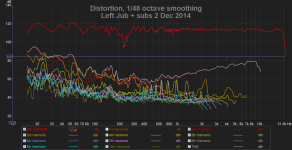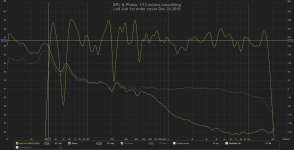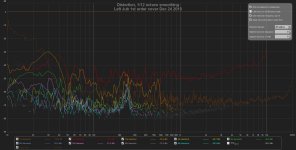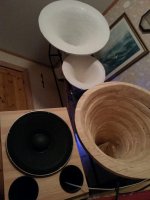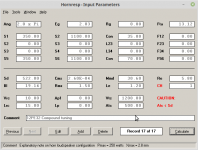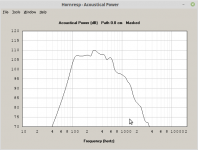Not sure whether it's Klipsch own measurement or someone else's. The in-room measurements I've seen show the same issues. Seems to be the nature of a V folded horn. Some can probably be addressed with EQ.
I don't think it's Klipsch's measurements - if for no other reason, because they don't provide responses for any other speakers of theirs. The K-horn (and any bass horn for that matter but the K-horn especially) presents a nearly impossible obstacle when making measurements of its response in that it needs a room corner of appropriate size (much larger than the speaker) in order to perform as intended. Therefore, I would doubt very much that these measurements or earlier ones have been made in a anechoic chamber with the K-horn appropriately installed inside a corner of adequate dimensions.
I don't think it's Klipsch's measurements - if for no other reason, because they don't provide responses for any other speakers of theirs. The K-horn (and any bass horn for that matter but the K-horn especially) presents a nearly impossible obstacle when making measurements of its response in that it needs a room corner of appropriate size (much larger than the speaker) in order to perform as intended. Therefore, I would doubt very much that these measurements or earlier ones have been made in a anechoic chamber with the K-horn appropriately installed inside a corner of adequate dimensions.
I have been in the anechoic chambers at both the Indianapolis HQ, and in Hope, Arkansas facilities that Klipsch operates. Both anechoic chambers have a rotating door that features a built in corner, and an air bladder seal.
Here's a picture of the rotating door ( corner ) of the chamber.

Thanks for sharing diyuser2010.
Here's one in room measurement of the Jubilee with subs. EQ might have been applied. Take note that the resolution of the Y graph is only 20 dB.
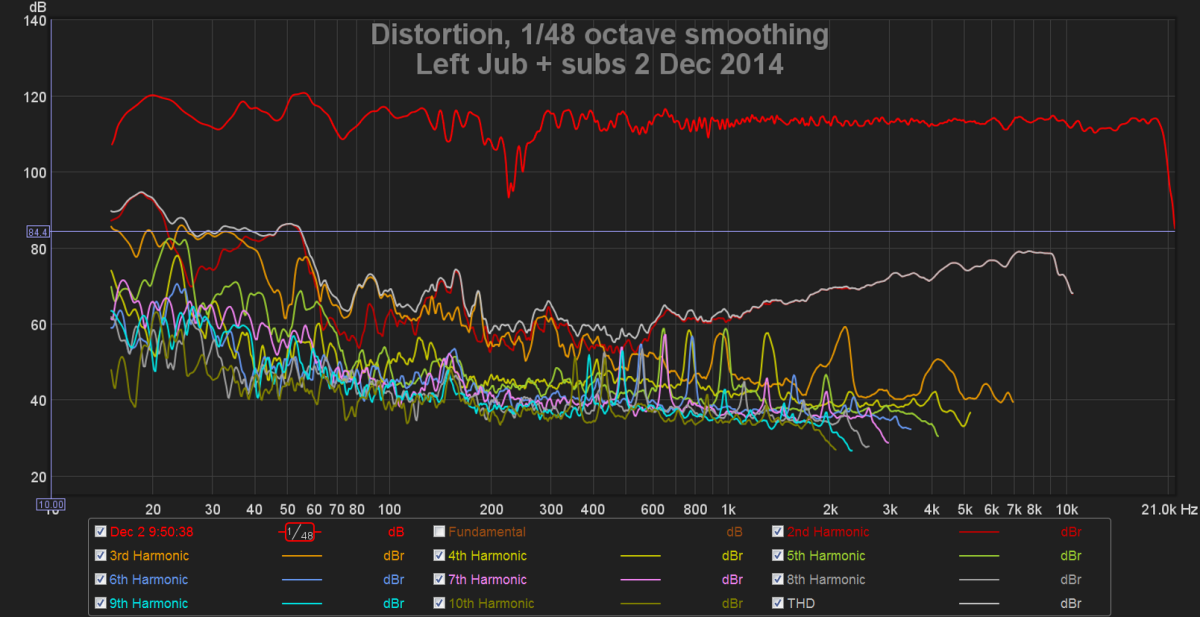
This doesn't mean I think the bass bin of the Jubilee is a poor construction, but I do believe it can be improved.
Corner placement has the advantage of using the room as an extension of the horn. But it also has disadvantages IMO. Some of the depth is often lost when speakers are placed close to front wall. Part of this is visual and a psychological effect, but it still matters to me. While the side walls are an extension of the horn, it will also cause some early arriving specular reflections, and which are difficult to deal with properly because boundary is so close and it's difficult to treat sufficiently broadband due to lack of space. Taking up space for corner bass trapping is another weakness IMO. Plus corner placement requires a room that suits it, something that's rare here in Scandinavian homes at least.
Using a big midbass horn that can be placed further from the walls and still remain directivity low in frequency and placing the separate sub(s) close to the corner or where they measure best is a better solution the way I see it. The downside is the complexity and size.
Here's one in room measurement of the Jubilee with subs. EQ might have been applied. Take note that the resolution of the Y graph is only 20 dB.
This doesn't mean I think the bass bin of the Jubilee is a poor construction, but I do believe it can be improved.
Corner placement has the advantage of using the room as an extension of the horn. But it also has disadvantages IMO. Some of the depth is often lost when speakers are placed close to front wall. Part of this is visual and a psychological effect, but it still matters to me. While the side walls are an extension of the horn, it will also cause some early arriving specular reflections, and which are difficult to deal with properly because boundary is so close and it's difficult to treat sufficiently broadband due to lack of space. Taking up space for corner bass trapping is another weakness IMO. Plus corner placement requires a room that suits it, something that's rare here in Scandinavian homes at least.
Using a big midbass horn that can be placed further from the walls and still remain directivity low in frequency and placing the separate sub(s) close to the corner or where they measure best is a better solution the way I see it. The downside is the complexity and size.
Attachments
I have been in the anechoic chambers at both the Indianapolis HQ, and in Hope, Arkansas facilities that Klipsch operates. Both anechoic chambers have a rotating door that features a built in corner, and an air bladder seal.
...
Here's a picture of the rotating door ( corner ) of the chamber.
That is quite impressive. Have you got any photos of the anechoic chamber by any chance?
Do you know what the point of the turnstile is? Is it to ease the ins and outs of multiple K-horns under test?
The point I'm trying to make is, I think, that experimenters should not rely on frequency responses appearing here and there but rather should measure their own under the conditions that matter to them. There's just too many unknown factors that are not mentioned accompanying published measurements. K-horns have been through many iterations and their drivers' responses are unknown. Of course it depends on what the experimenter's goals are but what I'm referring to here is determining the in-room horn response.
For me there is a fundamental problem with the K-horn that I can't help wondering about. This is the discontinuity at the boundary of the horn mouth and the room corner which is presented by the size of the front baffle (but also the top of the speaker). This means that the conical horn flare rate at the room-speaker boundary is much larger than that of a room corner. The question is, at what frequency does that begin to matter and how much?
Is it worth trying to address it?
That is quite impressive. Have you got any photos of the anechoic chamber by any chance?
Do you know what the point of the turnstile is? Is it to ease the ins and outs of multiple K-horns under test?
The point I'm trying to make is, I think, that experimenters should not rely on frequency responses appearing here and there but rather should measure their own under the conditions that matter to them. There's just too many unknown factors that are not mentioned accompanying published measurements. K-horns have been through many iterations and their drivers' responses are unknown. Of course it depends on what the experimenter's goals are but what I'm referring to here is determining the in-room horn response.
For me there is a fundamental problem with the K-horn that I can't help wondering about. This is the discontinuity at the boundary of the horn mouth and the room corner which is presented by the size of the front baffle (but also the top of the speaker). This means that the conical horn flare rate at the room-speaker boundary is much larger than that of a room corner. The question is, at what frequency does that begin to matter and how much?
Is it worth trying to address it?
I did not take any pictures in the chamber, though the 'floor' is expanded metal grating suspended many feet over fiberglass wedges that are several feet deep. Each floor section can be removed independently from one another.
I have listened to speakers playing a descending sweep in the chamber standing behind them. You can barely discern that there is any noise at all, that is until the baffle step frequency occurs, and sound wraps around the enclosure, when it becomes incredibly loud.
The only entry point to the chamber is the corner. One of the surfaces of the rotating door is covered in fiberglass wedges.
Regarding your post about in-room response of horns, perhaps read the following link, how boundaries affect loudspeakers:
https://www.prosoundtraining.com/site/wp-content/uploads/2012/03/VOL36_DEC08_Boundaries-1.pdf
A K-horn not properly sealed into the corner will exhibit a loss of output between 250 and 500 hz.
Vol. 2. No. 12, 10 November 1961 Dope From Hope "Bob Rorer of High Fidelity Unlimited, Portland, Oregon, must be given the credit for discovery of a response dip in the region of 250-500 cycles per second in the KLIPSCHORN woofer."

Here's a more recent in-room measurement of that same two-way Klipsch Jubilee w/TAD TD-4002 driver (complete with room modes and microphone/boundary 1/4 wave cancellations at 50, 212, and 424 Hz) using IIR filters only:
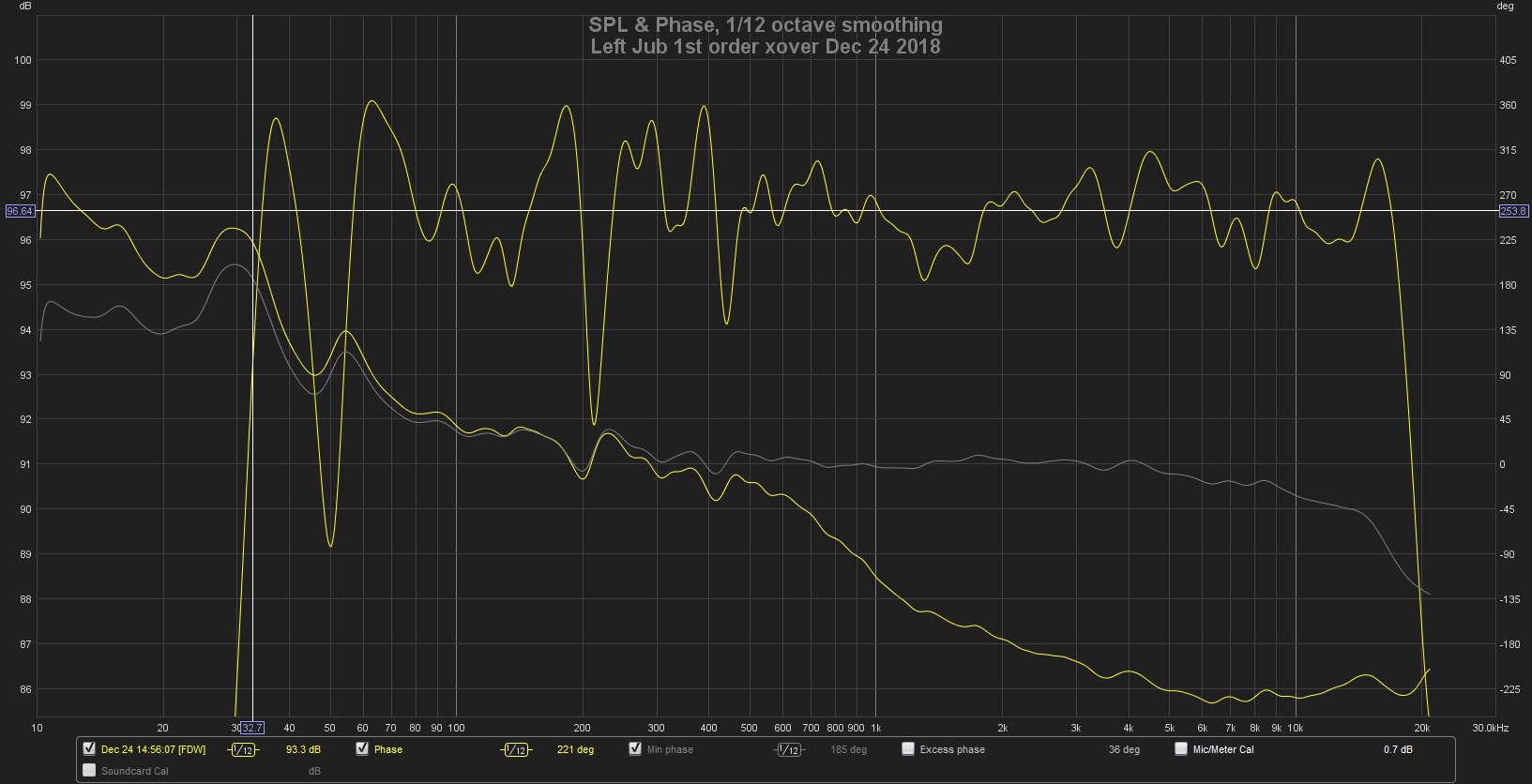
Your comments about the Jub bass bin seem a bit odd to me. I don't believe that a midbass horn mouth sticking far out in front of the K-402 either looks very good--or sounds very good either, due to the resulting requirement to have to stand back several metres in order to get a coalescing of the two horn's outputs. But it's obviously personal taste. Adding wings and a nose piece to the Jub bass bin is very doable and much more space efficient IMHO--like the following:

Here is a harmonic distortion plot of that same measurement (~96.5 dB on-axis at one metre). The distortion levels at frequencies below 100 Hz are lower than any subwoofer alternatives (that I can actually get into my listening room), that I've seen measurements for (at 96.5 dB), particularly modulation distortion:
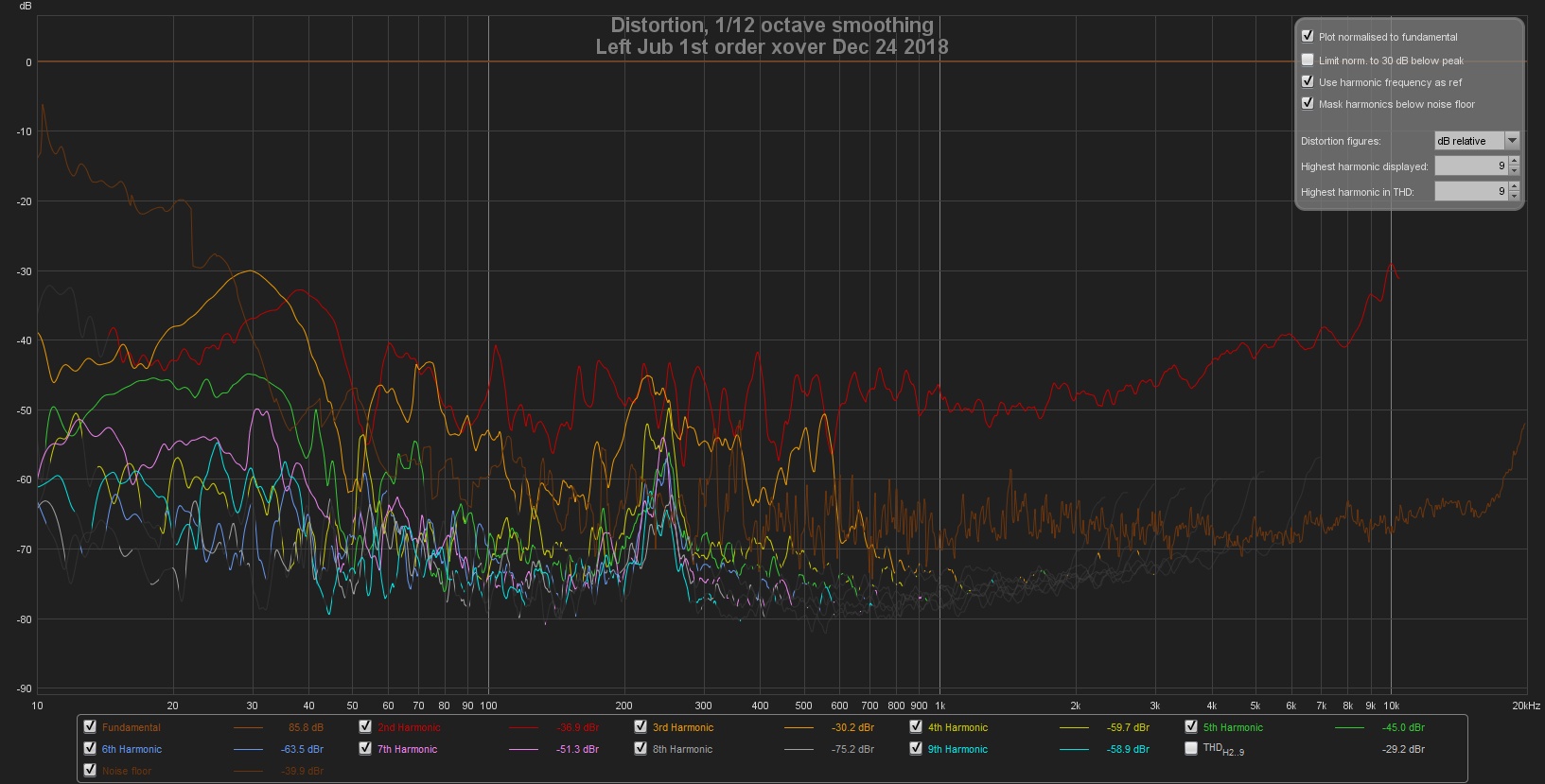
Chris
Your comments about the Jub bass bin seem a bit odd to me. I don't believe that a midbass horn mouth sticking far out in front of the K-402 either looks very good--or sounds very good either, due to the resulting requirement to have to stand back several metres in order to get a coalescing of the two horn's outputs. But it's obviously personal taste. Adding wings and a nose piece to the Jub bass bin is very doable and much more space efficient IMHO--like the following:

Here is a harmonic distortion plot of that same measurement (~96.5 dB on-axis at one metre). The distortion levels at frequencies below 100 Hz are lower than any subwoofer alternatives (that I can actually get into my listening room), that I've seen measurements for (at 96.5 dB), particularly modulation distortion:
Chris
Attachments
I could not decide on midbass solution either so naturally I built both a ported JBL 2225H cabinet and a hornloaded JBL 2220H. I did consider a corner horn but I was lacking a good corner with good solid pine tree to reflect the midbass. I can not rely on a thin plaster wall for midbass horn duty.
The ported sounded more correct, but a bit boring compared to feeling of being at a live concert I got from the horn loaded 2220H. Single instrument jazz was fantastic on horns, and with all that sensitivity I could here a pin drop in the recording. With more complex material, the 2225H was better, as if the mastering engineer did not use a horn speaker to tune in the bass. Strange.
I would love to have space for both at the same time. During my experiment I had to bck away to the next room for a coherent soundstage between the horns.
The ported sounded more correct, but a bit boring compared to feeling of being at a live concert I got from the horn loaded 2220H. Single instrument jazz was fantastic on horns, and with all that sensitivity I could here a pin drop in the recording. With more complex material, the 2225H was better, as if the mastering engineer did not use a horn speaker to tune in the bass. Strange.
I would love to have space for both at the same time. During my experiment I had to bck away to the next room for a coherent soundstage between the horns.
Attachments
I did not take any pictures in the chamber, though the 'floor' is expanded metal grating suspended many feet over fiberglass wedges that are several feet deep. Each floor section can be removed independently from one another.
I have listened to speakers playing a descending sweep in the chamber standing behind them. You can barely discern that there is any noise at all, that is until the baffle step frequency occurs, and sound wraps around the enclosure, when it becomes incredibly loud.
Thank you for this - this is great info. I didn't quite realise what you meant by "any noise at all" and re-read that bit a few times until it dawned on me, it was the effect of the chamber you were referring to - very impressive once again.
Regarding your post about in-room response of horns, perhaps read the following link, how boundaries affect loudspeakers:
https://www.prosoundtraining.com/site/wp-content/uploads/2012/03/VOL36_DEC08_Boundaries-1.pdf
This seems like a nice, general overview of boundary effects. I'll go through it. I briefly went through the horn part. To clarify, by discontinuity I meant that at the K-horn's mouth between the speaker's exponential horn and the conical horn formed by the room corner. The mouth of the K-horn has a much smaller area than the conical horn's throat. The K-horn is meant to take advantage of the latter when the latter presents an appropriate loading. To what extent this advantage can be achieved (by improving or modifying the K-horn) is the question.
A K-horn not properly sealed into the corner will exhibit a loss of output between 250 and 500 hz.
Vol. 2. No. 12, 10 November 1961 Dope From Hope "Bob Rorer of High Fidelity Unlimited, Portland, Oregon, must be given the credit for discovery of a response dip in the region of 250-500 cycles per second in the KLIPSCHORN woofer."
This is great - it's the first time I see the effect of the improper fitting quantified. One more great bit of info is that about the interference between the two sides of the bass horn. Although seemingly obvious, I never thought of looking at the effect of the split horn in this way - a useful simplification.
Thank you for this - this is great info. I didn't quite realise what you meant by "any noise at all" and re-read that bit a few times until it dawned on me, it was the effect of the chamber you were referring to - very impressive once again.
This seems like a nice, general overview of boundary effects. I'll go through it. I briefly went through the horn part. To clarify, by discontinuity I meant that at the K-horn's mouth between the speaker's exponential horn and the conical horn formed by the room corner. The mouth of the K-horn has a much smaller area than the conical horn's throat. The K-horn is meant to take advantage of the latter when the latter presents an appropriate loading. To what extent this advantage can be achieved (by improving or modifying the K-horn) is the question.
This is great - it's the first time I see the effect of the improper fitting quantified. One more great bit of info is that about the interference between the two sides of the bass horn. Although seemingly obvious, I never thought of looking at the effect of the split horn in this way - a useful simplification.
I can't be 100% certain, but I recall that the chamber at both Hope AR, and Indianapolis are anechoic down to about 85 hz, or so. It has been quite a few years since I was at either facility. Standing in the closed chamber with no perceptible reflections or other stimuli is a rather strange experience, and you can hear the blood being pumped through your veins.
I have never modeled the bass horn, though I am certain other people have measured the area expansion, and can qualify it as a certain flare profile.
Here's a picture of a clear Klipschorn:

I'd expect the upper end of the bandwidth to be more affected by any discontinuity, but I will defer to an expert in modelling with horn resp or akabak.
Is this any good?
I played around with the different options in Hornresp and came up with this:
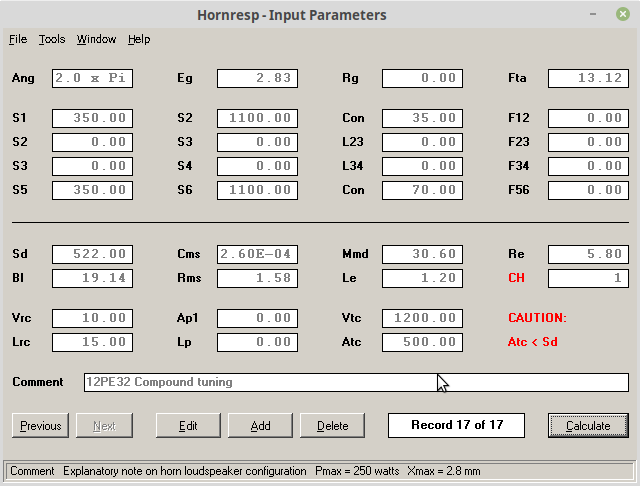
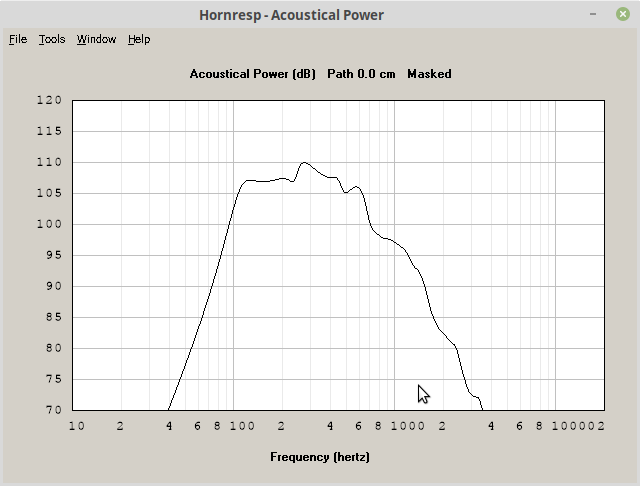
I was trying to have something like A7 horn with bass reflex to use from 100 Hz up to 500 Hz - something not too deep. TH below 100 Hz and JBL2445 above 500 Hz. And then I thought how about a TL instead of the BR.
I am pretty sure this has been done before, is this idea worth trying? The front horn would be as usual and the back horn would be folded so that it exits below the front horn.
I played around with the different options in Hornresp and came up with this:
I was trying to have something like A7 horn with bass reflex to use from 100 Hz up to 500 Hz - something not too deep. TH below 100 Hz and JBL2445 above 500 Hz. And then I thought how about a TL instead of the BR.
I am pretty sure this has been done before, is this idea worth trying? The front horn would be as usual and the back horn would be folded so that it exits below the front horn.
Attachments
Hmm, how about a double 12pe32 front horn, no folding ?
Any way to model 3pi?
Horn on the floor is not 2pi unless mouth is emptying out attached to the middle of concrete floor.
But better than free air (4pi).
Still have to cross at 750 demanding a big horn.
I think it would be a sweet but deep performer, maybe flat to 150 or even 150hz.
Wish i had the room...........
Any way to model 3pi?
Horn on the floor is not 2pi unless mouth is emptying out attached to the middle of concrete floor.
But better than free air (4pi).
Still have to cross at 750 demanding a big horn.
I think it would be a sweet but deep performer, maybe flat to 150 or even 150hz.
Wish i had the room...........
Last edited:
- Home
- Loudspeakers
- Multi-Way
- Pros and cons of different midbass horns
